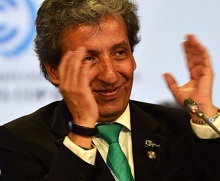Seems the most important thing that can be said about the Lima climate change conference (earlier post here) was that it did not fail. The prospect is still there for a deal in Paris next December, but it looks like being a weak deal – a deal that does not limit warming to two degrees, a deal that will not be legally binding, and a deal that may lack some of the major participants.
The most exciting thing about the conference was that the reference to ensuring the world has net-zero emissions by 2050 is still there:
The mitigation section of the draft text states countries must aim for “a long-term zero emissions sustainable development pathway” that is “consistent with carbon neutrality / net zero emissions by 2050, or full decarbonization by 2050 and/or negative emissions by 2100.”
Giles Parkinson says this was explicitly supported by over 100 countries. Julie Bishop was not bloody-minded enough to insist that it be removed.
The phasing out of fossil fuels as a reality is now part of the conversation and capital for fossil fuel exploration and development should begin to dry up.
Once again The Carbon Brief provides a handy summary:
- Lima Call for Climate Action outlines main aspects of a new global climate deal.
- Keeps goal of limiting global warming to less than two degrees.
- Contains reference to ensuring the world has net-zero emissions by 2050.
- Doesn’t clarify if a new deal will be legally binding.
- Doesn’t give countries the power to alter other country commitments.
- Doesn’t offer new assurances on the flow of climate finance.
- Leaves all options on the table regarding compensation for countries worst hit by climate change.
Ambition
The principle of ‘common but differentiated responsibility’ is enshrined by the United Nations Framework Convention on Climate Change. Accordingly in the Kyoto deal only the developed countries were required to limit emissions.
This time everyone is going to have to front with a climate mitigation plan, but
countries must work to ensure a 2015 deal “reflects the principle of common but differentiated responsibilities and respective capabilities, in light of different national circumstances.”
Initial plans should be submitted by March. Australia has said that we will submit ours by June. Work has not yet begun, but it is clear that Tony Abbott himself is going to take control of the process.
The UN will do an analysis and report on the overall impact of the country targets by November. There is no chance that it will add up to a plan to limit warming to two degrees.
The EU wants ‘contributions’, once established to stand for 10 years. Some other countries favour five years, for greater flexibility.
Legally binding
The EU, some of the smaller countries and Australia want targets, once set, to be legally binding. There seems no chance that this will happen. Luke Kemp at The Conversation says that for the US to agree two-thirds of the Senate have to vote in favour. They won’t vote for a legally binding agreement and China won’t sign up unless the US does.
Frankly, I can’t see the US Senate agreeing to any kind of a climate deal in the foreseeable future, so the Paris deal, like Kyoto, may have to start without some of the major players.
Kemp says that Australia was softening its stance, so fears that Australia was playing a game to torpedo the talks seem to be misplaced.
Accountability
Each country’s official plan to cut emissions and tackle climate change will be known as an ‘intended nationally determined contribution’ (INDC). The conference could not agree whether INDCs should be scrutinised.
The EU is willing to agree to the INDC system if governments can scrutinise each country’s INDCs, and suggest how they may need to change to increase ambition. Other countries, such as China and India, are very much against such scrutiny, known in the process as ‘ex-ante review’.
Lima’s draft text doesn’t determine whether the INDCs will be subjected to official review.
I’d say forget it.
What next?
There was more, of course, including financial assistance (never satisfactory). The draft document contains as many as 11 alternative versions of the text. There is masses of work to do.
Work will continue in various working parties and in a major conference in Bonn in June. No doubt discussions will continue in other forums, such as the G20 in Turkey. The next step is to submit INDCs by March. We’ll cheat by looking at everyone else’s homework. So will the Abbottistas be proudly recalcitrant, or will we track near the back of the peloton but try to pretend we are in the middle?
Elsewhere Graham Readfearn has annotated Julie Bishop’s speech.


Digressing a little, gizmag has put up this article which highlights an unseen polluter.
http://www.gizmag.com/shipping-pollution/11526/
At the end of the article the question is asked why there is no mention of nuclear powered container ships. I have been asking this question for some years. The only public suggestion of this was from the CEO of Cosco shipping some few years ago.
This issue has slipped out of sight because that is very much where the ships operate, but they do come into port. When Julia Gillard was opening some new port facility in WA I raised the question then as to how Australia was preparing for the inevitable introduction of Nuclear powered ships.
It is not until real numbers are applied to a problem that mids start to work to find the alternatives, just as it did for alternative energy for home energy consumers.
John Quiggin has written on Lima: the not-so-bad news at Inside Story, with a link at his place.
He’s looked at climate negotiations from the perspective of the Montreal Protocol on chlorofluorocarbons.
Also he’s picked up the important point that previously agreed target of limiting global warming to 2 degrees Celsius has been strengthened to “below 2 or 1.5 degrees C above pre-industrial levels.”